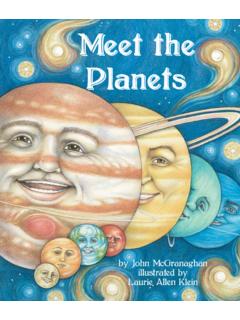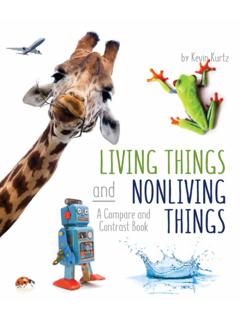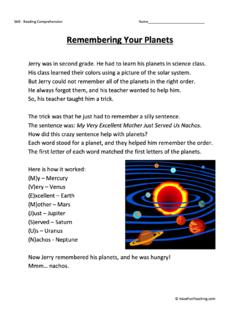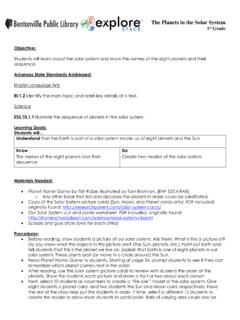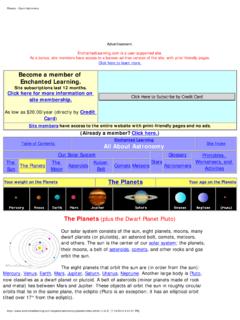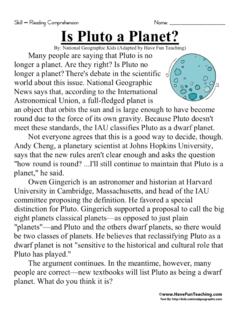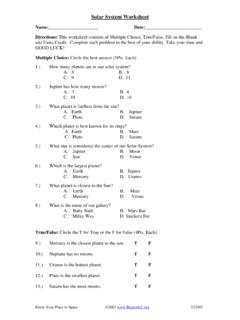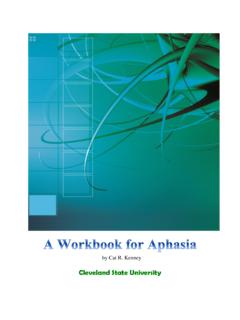Transcription of Teaching Activity Guide Meet the Planets
1 Teaching Activity GuideMeet thePlanetsTable of Contents3 How to Use This Activity Guide4 What Do Children Already Know?4 Pre- reading Questions5 Thinking It Through & Writing Prompts5 comprehension Questions6 Find in the Art8 People of History in the Art11 Vocabulary Game11 Using the Words12 Silly Sentence Structure Activity13 Sequence Sentence Strips15 Word Search16 Solar System Cards21 Rotation or Revolution?22 Science Journal24 True or False?25 Which Planet?26 Temperatures27 Scale and Distance30 Coloring Pages33 Glossary39 Answers51 Appendix A What Children Know Cards52 Appendix B Venn Diagram53 Appendix C Vocabulary CardsCopyright 2011 Arbordale PublishingThese activities may be copied for personal and non-commercial use in educational Publishingformerly Sylvan Dell PublishingMt. Pleasant, SC 29464by John McGranaghanillustrated by Laurie Allen KleinHow to Use This Activity GuideThere are a wide variety of activities that teach or supplement all curricular areas.
2 The activities are easily adapted up or down depending on the age and abilities of the children involved. And, it is easy to pick and choose what is appropriate for your setting and the time involved. Most activities can be done with an individual child or a group of children. Glossary/Vocabulary words: Words may be written on index cards, a poster board, or on a chalkboard for a word wall. If writing on poster board or chalkboard, you might want to sort words into nouns, verbs, etc. right away to save a step later if using for Silly Sentences. Leaving the words posted (even on a refrigerator at home) allows the children to see and think about them frequently. The glossary has some high-level words. Feel free to use only those words as fit your situation. Silly Sentence Structure Activity : Game develops both an understanding of sentence structure and the science subject.
3 Use words from the word wall to fill in the blanks. After completing silly sentences for fun, have children try to fill in the proper words by looking for the information in the Sentence Strips: Cut into sentence strips, laminate if desired, and place in a center. Have children put the events in order. Children may work alone or in small groups. Cards are in order but should be mixed up when cut Card Games:Memory Card Game: Make two copies of each of the sorting card pages and cut out the cards. Or make one copy of the regular Planets and match to thel personality planet. Mix them up and place them face down on a table. Taking turns, each player should turn over two cards so that everyone can see. If the cards match, he or she keeps the pair and takes another turn. If they do not match, the player should turn the cards back over and it is another player s turn.
4 The player with the most pairs at the end of the game Am I? Copy and cut out the cards. Poke a hole through each one and tie onto a piece of yarn. Have each child put on a card necklace without looking at the planet pictured on it. The card hangs down the back. The children get to ask each person one yes/no question to try to guess their planet. If a child does not know the answer, they should say they don t know. This is a great group Activity and a great ice-breaker for children who don t really know each suggested or initial yes/no questions include:Am I an inner planet? If the answer is no, you know you are an outer planet. ORDo I have rings? If the answer is yes, you know you are an outer planet, if no, you know you are an inner planet. Do I have moons?Does life exist on me? Arbordale Publishing 3 Return to Table of ContentsWhat Do Children Already Know?
5 Young children are naturally inquisitive and are sponges for information. The whole purpose of this Activity is to help children verify the information they know (or think they know) and to get them thinking beyond the box about a particular subject. Before reading the book, ask the children what they know about the subject. A list of suggested questions is below. The children should write down their answers (or adults for them if the children are not yet writing) on the chart found in Appendix A, index cards, or post-it notes. Their answers should be placed on a before reading panel. If doing this as a group, you could use a bulletin board or even a blackboard. If doing this with individual children, you can use a plain manila folder with the front cover the before reading panel. Either way, you will need two more panels or sections one called correct answer and the other look for correct answer.
6 Do the children have any more questions about the subject ? If so, write them down to see if they are answered in the reading the book, go back to the questions and answers and determine whether the children s answers were correct or not. If the answer was correct, move that card to the correct answer panel. If the answer was incorrect, go back to the book to find the correct information. If the child/children have more questions that were not answered, they should look them up. When an answer has been found and corrected, the card can be moved to the correct answer readingcorrectanswerlook forcorrect answerQuestions: what class of animal is a dog?Answers: A dog is a mammal, like us. Questions: what class of animal is a dolphin?Answers: A dolphin is a mammal, like us. Questions: what class of animal is a parrot?Answers: A a parrot is a bird because it has feathers.
7 Pre- reading Questions Arbordale Publishing 4 Return to Table of ContentsHow many Planets are in our solar system?What is the name of the planet we live on?What are the names of the other Planets in our solar system?What are some things you know about some of the other Planets ?Do all Planets have a moon?Do any Planets have more than one moon?Around what do the Planets revolve?What is the sun? What are some other things that are in our solar system?When did people start studying the night sky?How do scientists use a telescope to study the Planets ?What other ways to scientists study Planets or their moons?Thinking It Through & Writing PromptsWrite a song about the Planets or the sun. Can you think of another title for the book?Why do you think people used to believe that the Earth was the center of the universe?What was the first planet to be discovered by a telescope?
8 How were the other Planets discovered?What are some examples of other tools and technology scientists can use to study the Planets besides a telescope?Identify one scientist from the illustrations and desribe why his (or her) contribution was is a lot we still don t know about our solar system. Write about something you want to know Questions Arbordale Publishing 5 Return to Table of ContentsWhat is the competition for?What are the inner Planets and what do they have in common?List the outer Planets and what do they have in common?How big is the red spot on Jupiter?What is the planet that is often mistaken for a star? Which planet is the fastest moving in our solar system?Which planet s two poles get 42 years of sunlight and 42 years of darkness?Which planet was named for the Roman King of the sea?Which planet is slanted?Which planet is not named after a Greek or Roman god?
9 Find in the ArtIllustrator Laurie Allen Klein added all kinds of extra things to the art. Descriptions and explanations of who people were, what things are, or even why she used certain colors or layout are explained in the Answer :Callisto: one of Jupiter s moonsDeimos: one of Mars moonsEnceladus: one of Saturn s moonsEuropa: one of Jupiter s moonsGanymede: one of Jupiter s moonsIapetus: one of Saturn s moonsIo: one of Jupiter s moonsMimsa: one of Saturn s moonsMiranda: one of Uranus moonsOberon & Titania: two of Uranus moonsPhobos: one of Mars moonsTitan: one of Saturn s moonsTriton: one of Neptune s moonsConstellations:Big and Little DippersCassiopiaCepheus the KingDraco the DragonGeminiLeo the LionProbes and SpacecraftsCassini Space Probe: launched in 2004, this mission is still exploring Saturn and its moonsHuygens Probe : dropped from the Cassini spacecraft and landed on Titan to transmit dataMagellan.
10 US planetary probe to Venus in 1994 Mariner 1: First planetary explorer attempted to fly by Venus in 1962 but veered off courseMessenger: launched in 2004, this mission is currently exploring MercurySojourner: a rover that collected samples and date from the Martian surface in 1977 Venera 14: A Russian probe that landed on Venus in 1982 and sent back photos & data for 57 minutes before meltingVoyager 2: launched in August, 2007, this spacecraft sent back photos of all of the outer planetsStonehenge was built between 2900 BC and 1600 BC, probably by the Druids. This ancient group of stone monuments could have been some kind of astronomical observatory or symbols in the art Arbordale Publishing 6 Return to Table of ContentsThe layout, and general look, of the Venus page illustration is based on Botticelli s Birth of Venus. Compare and contrast the crowd on the introductory illustration was inspired by the engraving done of the Ptolemaic Universe in 1490.
